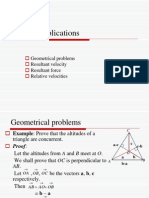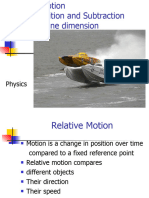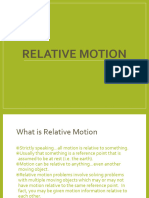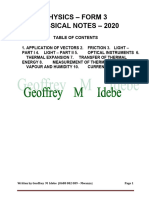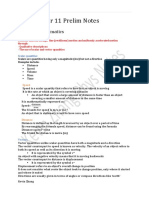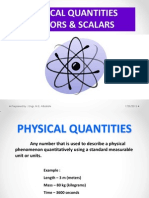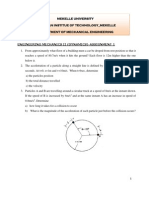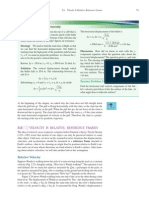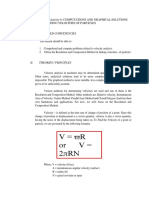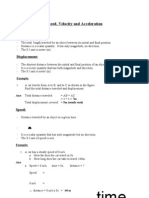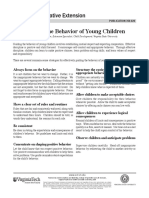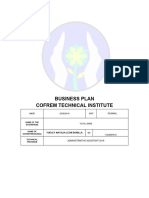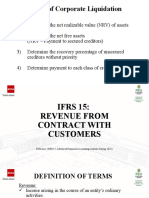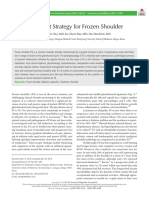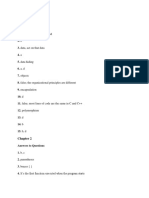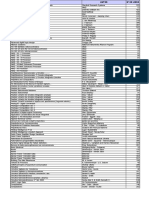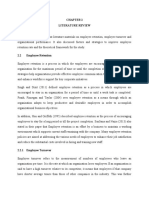0 ratings0% found this document useful (0 votes)
43 views1 Relative Motion
1 Relative Motion
Uploaded by
TABIBI111) The document discusses concepts related to relative motion and vector addition and subtraction, including relative velocity, resultant velocity, and graphical methods for adding and subtracting vectors.
2) It provides examples of calculating relative velocity between objects, as well as adding vectors that are at different angles to find the resultant velocity.
3) Motion in two dimensions is examined, including cases where velocity has components in perpendicular directions, such as a boat traveling in a river. The Pythagorean theorem and trigonometry are used to analyze such situations.
Copyright:
© All Rights Reserved
Available Formats
Download as PPT, PDF, TXT or read online from Scribd
1 Relative Motion
1 Relative Motion
Uploaded by
TABIBI110 ratings0% found this document useful (0 votes)
43 views26 pages1) The document discusses concepts related to relative motion and vector addition and subtraction, including relative velocity, resultant velocity, and graphical methods for adding and subtracting vectors.
2) It provides examples of calculating relative velocity between objects, as well as adding vectors that are at different angles to find the resultant velocity.
3) Motion in two dimensions is examined, including cases where velocity has components in perpendicular directions, such as a boat traveling in a river. The Pythagorean theorem and trigonometry are used to analyze such situations.
Original Description:
physics
Copyright
© © All Rights Reserved
Available Formats
PPT, PDF, TXT or read online from Scribd
Share this document
Did you find this document useful?
Is this content inappropriate?
1) The document discusses concepts related to relative motion and vector addition and subtraction, including relative velocity, resultant velocity, and graphical methods for adding and subtracting vectors.
2) It provides examples of calculating relative velocity between objects, as well as adding vectors that are at different angles to find the resultant velocity.
3) Motion in two dimensions is examined, including cases where velocity has components in perpendicular directions, such as a boat traveling in a river. The Pythagorean theorem and trigonometry are used to analyze such situations.
Copyright:
© All Rights Reserved
Available Formats
Download as PPT, PDF, TXT or read online from Scribd
Download as ppt, pdf, or txt
0 ratings0% found this document useful (0 votes)
43 views26 pages1 Relative Motion
1 Relative Motion
Uploaded by
TABIBI111) The document discusses concepts related to relative motion and vector addition and subtraction, including relative velocity, resultant velocity, and graphical methods for adding and subtracting vectors.
2) It provides examples of calculating relative velocity between objects, as well as adding vectors that are at different angles to find the resultant velocity.
3) Motion in two dimensions is examined, including cases where velocity has components in perpendicular directions, such as a boat traveling in a river. The Pythagorean theorem and trigonometry are used to analyze such situations.
Copyright:
© All Rights Reserved
Available Formats
Download as PPT, PDF, TXT or read online from Scribd
Download as ppt, pdf, or txt
You are on page 1of 26
-Relative Motion
-Vector Addition and Subtraction
-Motion in Two Dimensions Intro
Physics
Mrs. Coyle
Part I
Relative Velocity
Vector Addition and Subtraction
(Graphical)
Relative Velocity
Velocity of A relative to B:
V
AB
=V
A
-V
B
v
AB
: v of A with respect to B
v
B
: v of B with respect to a reference
frame (ex.: the ground)
v
A
: v of A with respect to a
reference frame (ex.: the ground)
Example 1
The white speed boat has a velocity of
30km/h,N, and the yellow boat a
velocity of 25km/h, N, both with respect
to the ground. What is the relative
velocity of the white boat with respect
to the yellow boat?
Answer: 5km/h, N
Example 2-
The Bus Ride
A passenger is seated on a bus that is
traveling with a velocity of 5 m/s, North.
If the passenger remains in her seat,
what is her velocity:
a) with respect to the ground?
b) with respect to the bus?
Example 2 -continued
The passenger decides to approach the
driver with a velocity of 1 m/s, N, with
respect to the bus, while the bus is moving
at 5m/s, N.
What is the velocity of the passenger with
respect to the ground?
Answer: 6m/s, N
Resultant Velocity
The resultant velocity is the net velocity
of an object with respect to a reference
frame.
Example 3- Airplane and Wind
An airplane has a velocity of 40 m/s, N,
in still air. It is facing a headwind of
5m/s with respect to the ground.
What is the resultant velocity of the
airplane?
What if you have motion in
two dimensions?
Motion in Two Dimensions
Constant velocity in each of two
dimensions (example: boat & river,
plane and wind)
Projectiles (constant velocity in one
dimension and constant acceleration in
the other dimension)
Graphical Addition of Vectors
Head-to-Tail Method
Parallelogram Method
Some rules to use for vector
addition:
Vectors can be moved parallel to
themselves. Their magnitude and
direction is still the same.
The order of vector addition does not
effect the resultant (commutative
property).
Head-to-Tail Method of
Method Addition
Move one vector parallel to itself, so that
its head is adjacent to the tail of the other
vector.
Draw the resultant by starting at the first
tail and ending at the last head.
B
Resultant
A
Add vectors A+B using the
head to tail method:
A
B
Resultant
Place the vectors tail to tail forming a
parallelogram.
Draw the diagonal from the two tails.
This is the resultant.
A
B
Resultant
Parallelogram Method of
Vector Addition
Note
If the drawing is done to scale,
measure the resultant.
Convert the value of the resultant using
the scale of the drawing.
Add vectors A+B using the
parallelogram method:
A
B
B
Resultant
Add the following vectors
using the head-to-tail method:
Resultant
Graphical Vector Subtraction
When subtracting A-B :
Invert vector B to get -B
Add A+(-B) normally
Subtract vectors A-B
graphically:
A
B
-B
Resultant
Part II
Constant velocity in each of two
dimensions (example: boat & river,
plane and wind)
Velocity
of Boat in
Still Water
Velocity
of River
with
respect to
the
ground
Adding vectors that are at 90
0
to each other.
Draw the vector diagram and draw the
resultant.
Use the Pythagorean Theorem to
calculate the resultant.
Use =tan
-1
(y/x) to find the angle
between the horizontal and the
resultant, to give the direction of the
resultant. (0
0
is along the +x axis)
Example 4-Airplane and Wind
An airplane is traveling with a velocity of 50
m/s, E with respect to the wind. The wind is
blowing with a velocity of 10 m/s, S. Find
the resultant velocity of the plane with
respect to the ground.
Answer: 51m/s, at 11
o
below the + x axis (E).
Independence of Vector
Quantities
Perpendicular vector quantities are
independent of one another.
Independence of Vector
Quantites
Example: The constant velocities in each of
the two dimensions of the boat & river
problem, are independent of each other.
Velocity
of Boat in
Still Water
Velocity
of River
with
respect to
the
ground
Example 5- Boat and River
A boat has a velocity of 4 m/s, E, in still
water. It is in a river of width 150m, that
has a water velocity of 3 m/s, N.
a) What is the resultant velocity of the boat
relative to the shore.
b) How far downstream did the boat travel?
Answer: a) 5m/s, @ 37
o
above + x axis (E)
b) 113m
You might also like
- Fundamentals of SurveyingDocument611 pagesFundamentals of Surveyingrvkumar361969092% (62)
- BillDocument4 pagesBillDinu Modded100% (1)
- ASD LRFD Structural Wood Design Solved Example Problems 2005 EditionDocument452 pagesASD LRFD Structural Wood Design Solved Example Problems 2005 EditionTABIBI1150% (4)
- Idebe P-3-1Document156 pagesIdebe P-3-1Charles Ghati100% (8)
- AP Physics ReviewDocument96 pagesAP Physics Reviewderekcal100% (7)
- The PE Exam Survival GuideDocument37 pagesThe PE Exam Survival GuideNarcisa Rudnic100% (1)
- Motion - Speed Velocity and AccelerationDocument51 pagesMotion - Speed Velocity and AccelerationJoric MagusaraNo ratings yet
- Vector ApplicationsDocument17 pagesVector ApplicationsCYNo ratings yet
- Civil PE Exam Sample ProblemsDocument17 pagesCivil PE Exam Sample ProblemsAnonymous IwqK1Nl100% (10)
- Civil Breadth Mor Questions 3Document47 pagesCivil Breadth Mor Questions 3JR ZunigaNo ratings yet
- Civil PE Exam Sample ProblemsDocument17 pagesCivil PE Exam Sample ProblemsAnonymous IwqK1Nl100% (10)
- READ. Mikes Civil Pe Exam Guide - Book SampleDocument18 pagesREAD. Mikes Civil Pe Exam Guide - Book SampleTABIBI11No ratings yet
- Pe Exam Books PDFDocument3 pagesPe Exam Books PDFTABIBI110% (1)
- Cortez Practice Set JanuaryDocument5 pagesCortez Practice Set JanuaryChristian LapidNo ratings yet
- Assignment 2Document6 pagesAssignment 2Tiger YanNo ratings yet
- Microsoft Word - SRSDocument5 pagesMicrosoft Word - SRSnonip100% (1)
- 1 Relative MotionDocument26 pages1 Relative MotionvvvNo ratings yet
- 1 Relative MotionDocument26 pages1 Relative MotionDena KaranNo ratings yet
- Relative Motion Power Point HSDocument27 pagesRelative Motion Power Point HSDan2929No ratings yet
- CH - 4 Motion in A PlaneDocument41 pagesCH - 4 Motion in A PlaneishayanarahtNo ratings yet
- Relative - MotionDocument29 pagesRelative - MotionDanmin YuNo ratings yet
- Topic 3.3 Relative VelocityDocument14 pagesTopic 3.3 Relative Velocitymya.thet.htar.06No ratings yet
- Lesson 6 Relative Motion REV 1Document23 pagesLesson 6 Relative Motion REV 1lorenzdearceusNo ratings yet
- Physics Techs Lesson 1Document47 pagesPhysics Techs Lesson 1Godspower OgbonnayaNo ratings yet
- Physics - Ch5 VectorsDocument25 pagesPhysics - Ch5 VectorsNur IffatinNo ratings yet
- IdebeDocument201 pagesIdebeahmedhamadsameerNo ratings yet
- Module 3 General Physics 1 q1Document12 pagesModule 3 General Physics 1 q1Jazelle DignoNo ratings yet
- Vectors vs. Scalars: Scalar QuantitiesDocument45 pagesVectors vs. Scalars: Scalar Quantitieslala2398No ratings yet
- MIT16 07F09 hw02Document7 pagesMIT16 07F09 hw02buddlightbeerlogNo ratings yet
- MotioninAPlane Paper 01Document9 pagesMotioninAPlane Paper 01nishantsingh232009No ratings yet
- Kinematics (Motion)Document32 pagesKinematics (Motion)Arshia HijabNo ratings yet
- Relative MotionDocument23 pagesRelative MotionkvinzonNo ratings yet
- Lecture Notes - Height and DistanceDocument8 pagesLecture Notes - Height and DistanceDinesh MatlaniNo ratings yet
- Relative Motion in One Dimension: P As Measured by B Plus The Velocity VDocument2 pagesRelative Motion in One Dimension: P As Measured by B Plus The Velocity VSyed AfrozNo ratings yet
- Lecture 8 Objective: - Describe Uniform Circular Motion - Solve Problems Involving Relative MotionDocument27 pagesLecture 8 Objective: - Describe Uniform Circular Motion - Solve Problems Involving Relative MotionKenneth OtsukaNo ratings yet
- Physical Quantities Vectors & ScalarsDocument41 pagesPhysical Quantities Vectors & ScalarsLin Xian Xing100% (1)
- Ch5 VectorsDocument25 pagesCh5 VectorsAriff AziziNo ratings yet
- Kinematics Questions PDFDocument18 pagesKinematics Questions PDFZsadist20No ratings yet
- Physics Year 11 Prelim NotesDocument53 pagesPhysics Year 11 Prelim NotesZain Al-Loos100% (1)
- 4-3 Relative Velocity in Two DimensionsDocument2 pages4-3 Relative Velocity in Two DimensionsEntertainment guruNo ratings yet
- Motion in 1DDocument24 pagesMotion in 1DhrprtNo ratings yet
- APPM 211 Week 4, Lesson4-Part 2 SlidesDocument13 pagesAPPM 211 Week 4, Lesson4-Part 2 Slidesruanhattingh037No ratings yet
- Methods of Problem Solving in KinematicsDocument7 pagesMethods of Problem Solving in KinematicsVikram AdityaNo ratings yet
- 11 Physics Imp Ch3 Marks 2Document11 pages11 Physics Imp Ch3 Marks 2Devendar SharmaNo ratings yet
- Relative Motion in One Dimension 1D and 2DDocument16 pagesRelative Motion in One Dimension 1D and 2DChristine RomanillosNo ratings yet
- PHY10T1VECTORSDocument40 pagesPHY10T1VECTORSChristiana Mae PadillaNo ratings yet
- Physics Hssc-I Test#3 (Morning) KeyDocument2 pagesPhysics Hssc-I Test#3 (Morning) KeyKainat UroojNo ratings yet
- Two Dimensional Motion and VectorsDocument5 pagesTwo Dimensional Motion and VectorsSriram ArumugamNo ratings yet
- Working With Vectors: Magnitude and DirectionDocument16 pagesWorking With Vectors: Magnitude and DirectionDyna MoNo ratings yet
- Linear Motion Question and Answer BookletDocument14 pagesLinear Motion Question and Answer Bookletmkunda487No ratings yet
- Lecture 6 - Constrained Motion and Relative VelocityDocument27 pagesLecture 6 - Constrained Motion and Relative VelocitymoatlhodiNo ratings yet
- Addition of Vectors PDFDocument18 pagesAddition of Vectors PDFMariella Del RioNo ratings yet
- Vector Addition and Subtraction: Graphical Methods: Openstax CollegeDocument22 pagesVector Addition and Subtraction: Graphical Methods: Openstax Collegepavi32No ratings yet
- Lopez Final Exam in College PhysicsDocument5 pagesLopez Final Exam in College PhysicsJohn Lloyd DaroNo ratings yet
- More Practice With River ProblemsDocument4 pagesMore Practice With River ProblemsWarrisha WarrishaNo ratings yet
- GISAGOLTANANPPTDocument143 pagesGISAGOLTANANPPTclarencemagbanua2020No ratings yet
- Motion in A Plane PDFDocument18 pagesMotion in A Plane PDFRohitNo ratings yet
- ME311 - 061 - Chapter5 (2) 22Document7 pagesME311 - 061 - Chapter5 (2) 22azoz173173173No ratings yet
- Fluid Force On A BendDocument6 pagesFluid Force On A Bendwild2west919670No ratings yet
- Chapter 4 Kinematics in Two DimensionDocument44 pagesChapter 4 Kinematics in Two DimensionAmar DanialNo ratings yet
- Dynamics Assignment 1Document7 pagesDynamics Assignment 1Addisu DagneNo ratings yet
- Projectile Motion Ihi ProblemsDocument5 pagesProjectile Motion Ihi ProblemsChesterAragonNo ratings yet
- Class - 9 - Measurement, Force and Motion, Sound...Document22 pagesClass - 9 - Measurement, Force and Motion, Sound...shivani.r.selvamNo ratings yet
- Velocity and AccelartionDocument56 pagesVelocity and Accelartionadus lakshmanNo ratings yet
- Module Kinematics Week 6 To 8Document13 pagesModule Kinematics Week 6 To 8Kriselle Keith NaragNo ratings yet
- AP Physics B Notes - Kinematics in One DimensionDocument8 pagesAP Physics B Notes - Kinematics in One DimensionAndy He100% (1)
- Average Speed Total Distance Total Time Distance Time Distance 8 SDocument8 pagesAverage Speed Total Distance Total Time Distance Time Distance 8 SRajesh MumtazNo ratings yet
- Handbook of Railroad Construction; For the use of American engineersFrom EverandHandbook of Railroad Construction; For the use of American engineersNo ratings yet
- The Mechanics of Water-Wheels - A Guide to the Physics at Work in Water-Wheels with a Horizontal AxisFrom EverandThe Mechanics of Water-Wheels - A Guide to the Physics at Work in Water-Wheels with a Horizontal AxisNo ratings yet
- S 001Document1 pageS 001TABIBI11No ratings yet
- The PE Exam Survival GuideDocument41 pagesThe PE Exam Survival GuideTABIBI11No ratings yet
- Table - : WidthDocument1 pageTable - : WidthTABIBI11No ratings yet
- May 2011 Board Exam All SubjectsDocument10 pagesMay 2011 Board Exam All SubjectsNarcisa Rudnic86% (14)
- Surveying Web TOC-1St Ed-SNDocument10 pagesSurveying Web TOC-1St Ed-SNTABIBI110% (3)
- Civil Breadth Mor Question 2 (Some Pages)Document20 pagesCivil Breadth Mor Question 2 (Some Pages)Pedro GarciaNo ratings yet
- 1prestressed ConcreteDocument112 pages1prestressed ConcreteTABIBI11No ratings yet
- Winter 2008 Asce Hawaii Section Ymf - Pe Exam Refresher CourseDocument3 pagesWinter 2008 Asce Hawaii Section Ymf - Pe Exam Refresher CourseTABIBI11No ratings yet
- Surveying by Dr. RamachandraDocument338 pagesSurveying by Dr. Ramachandravrsec-rao84% (19)
- Info For PE ExamDocument16 pagesInfo For PE ExamTABIBI11No ratings yet
- PE Exam App Instructions PDFDocument4 pagesPE Exam App Instructions PDFTABIBI11No ratings yet
- 350-020 PDFDocument2 pages350-020 PDFTABIBI11No ratings yet
- Winter 2008 Asce Hawaii Section Ymf - Pe Exam Refresher CourseDocument3 pagesWinter 2008 Asce Hawaii Section Ymf - Pe Exam Refresher CourseTABIBI11No ratings yet
- Business PlanDocument48 pagesBusiness PlanScribdTranslationsNo ratings yet
- List of NGP ProjectDocument22 pagesList of NGP ProjectCindyNo ratings yet
- AssignmentDocument753 pagesAssignmentclaudiaNo ratings yet
- Msds Na BenzoatDocument6 pagesMsds Na BenzoatDiana SekarNo ratings yet
- Process of Corporate LiquidationDocument56 pagesProcess of Corporate LiquidationJanelle CatoNo ratings yet
- History of NDMCDocument20 pagesHistory of NDMCChikoy Xhi100% (1)
- Chapter 1 - : To Operations ManagementDocument26 pagesChapter 1 - : To Operations ManagementSadam MangnejoNo ratings yet
- 2nd Mates Handout ARI F1 Bridge EquipmentsDocument95 pages2nd Mates Handout ARI F1 Bridge EquipmentsravelobeNo ratings yet
- Treatment Strategy For Frozen ShoulderDocument9 pagesTreatment Strategy For Frozen ShoulderDiah Rindayani HasbiNo ratings yet
- Building Your Company's VisionDocument14 pagesBuilding Your Company's VisionVikasdeep SharmaNo ratings yet
- Oop C++ Book Solution All Mcq's PDFDocument37 pagesOop C++ Book Solution All Mcq's PDFmitranNo ratings yet
- SikaWrap 230CDocument4 pagesSikaWrap 230Cakbarpelindo1No ratings yet
- Samsung Smart TVDocument8 pagesSamsung Smart TVwilliam mutheeNo ratings yet
- Libros 2009Document7 pagesLibros 2009Alberto Maximiliano CabralNo ratings yet
- PV Case StudyDocument3 pagesPV Case StudyAyush SonkeshariyaNo ratings yet
- CH 1 Events ManagementDocument31 pagesCH 1 Events Managementiishiiw67No ratings yet
- Employee TurnoverDocument16 pagesEmployee TurnoverAdekunle Damilola JoshNo ratings yet
- Detention Pond ExampleDocument0 pagesDetention Pond ExamplekwamehNo ratings yet
- Holiday Home Work FullDocument118 pagesHoliday Home Work FullLastking 17No ratings yet
- Engineering Economy ModulesDocument75 pagesEngineering Economy ModulesMarygrace AbayareNo ratings yet
- 1.01 GAAP PowerPoint 1-5Document56 pages1.01 GAAP PowerPoint 1-5Anonymous 1IzSQFJR100% (1)
- Ingles Vs Mutuc G.R. No. L-20390Document4 pagesIngles Vs Mutuc G.R. No. L-20390Maricel DefelesNo ratings yet
- IEC Law Seminar Week 11 - Preliminary References 1 202223Document3 pagesIEC Law Seminar Week 11 - Preliminary References 1 202223nneoma kengoldenNo ratings yet
- Full Download Eclipse TEA Revealed - Building Plug-ins and Creating Extensions for Eclipse Markus Duft PDF DOCXDocument65 pagesFull Download Eclipse TEA Revealed - Building Plug-ins and Creating Extensions for Eclipse Markus Duft PDF DOCXsainatriemkg100% (1)
- Minimal Invasive Dentistry: Dr. Rabab SalamaDocument36 pagesMinimal Invasive Dentistry: Dr. Rabab SalamanoursiliemNo ratings yet
- 05 eLMS Activity 1 (Final) - JIMWEL PEREZDocument2 pages05 eLMS Activity 1 (Final) - JIMWEL PEREZha3225023No ratings yet







